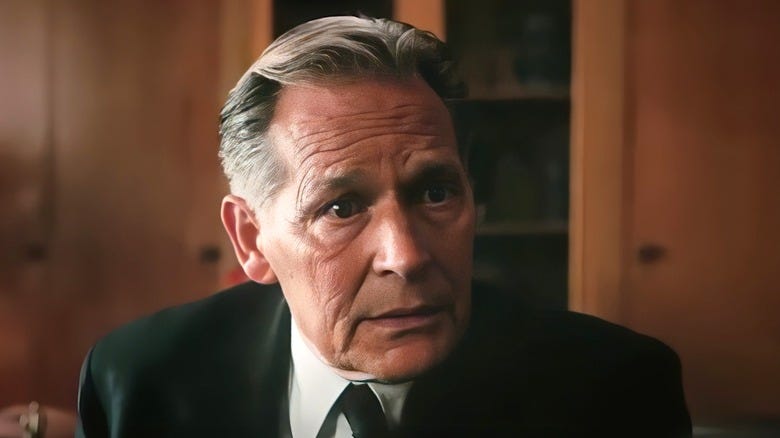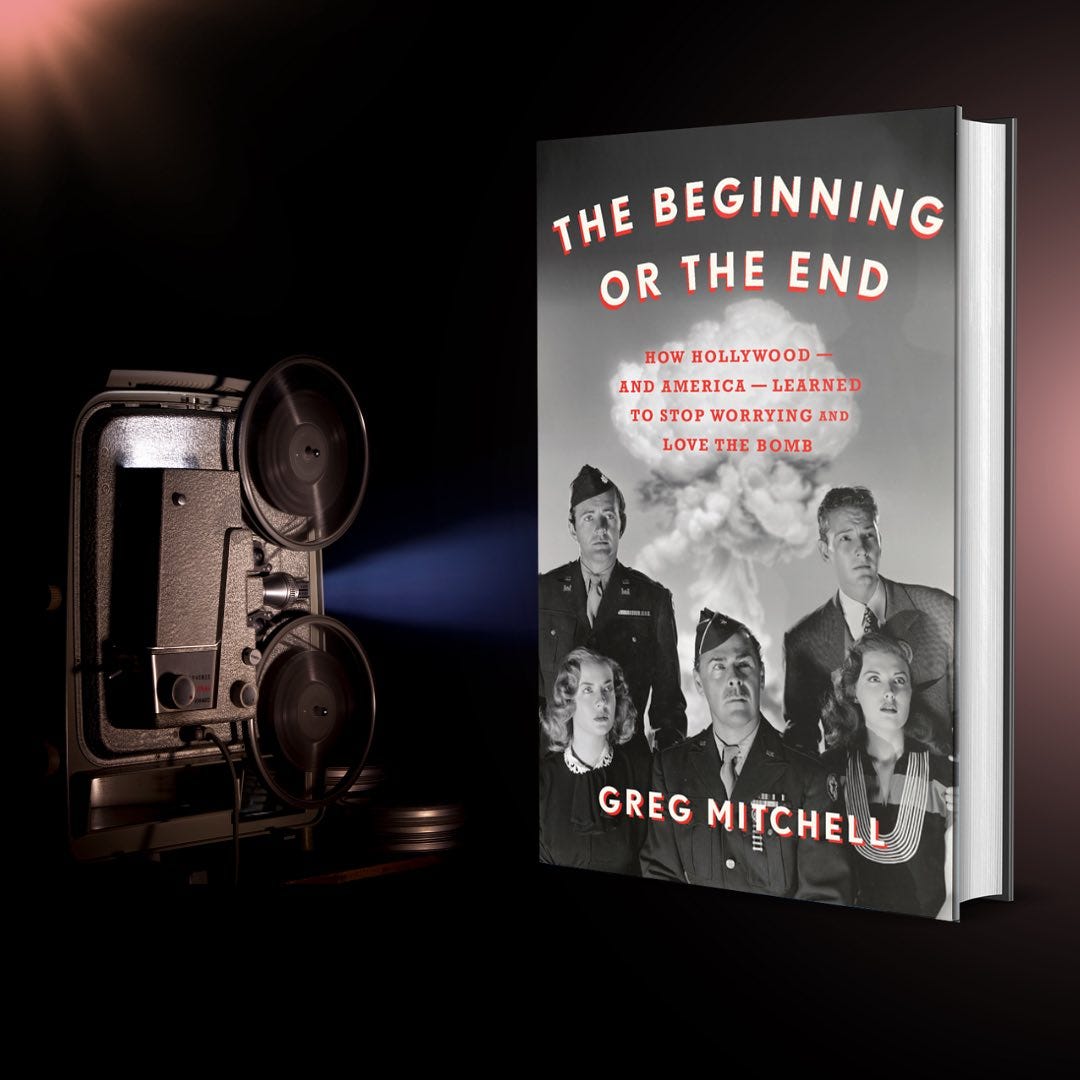From 'Oppenheimer' Script, Now Published: A Fictional Laugh Line--and Missing Victims
Nolan's addition and subtraction.
Greg Mitchell is the author of a dozen books, including “Hiroshima in America,” “Atomic Cover-up,” and the recent award-winning “The Beginning or the End: How Hollywood—and America—Learned to Stop Worrying and Love the Bomb.” He has directed three documentary films since 2021 for PBS (and “Atomic Cover-up” coming this fall). He has written widely about the atomic bombings for over forty years. You can subscribe to this newsletter for free.
As I hinted yesterday, I will now return to offering a few more notes, over several days, on the full script for Oppenheimer just published in paperback and, from the looks of it, selling like hotcakes. But first, if you dare, from The New York Times today: “Nuclear War Could End the World, but What if It’s All in Our Heads?”
As I wrote in my initial post last week, the published screenplay, over 200 pages long, follows very closely the dialogue, voice overs, and scenes in the movie, and only rarely did I find what I thought was a slightly changed, or a missing, line. Of course, I don’t have the movie on a screen in front of me at home to follow along, so I can’t be sure of that, but I would judge that this published screenplay mirrors the movie faithfully, by and large.
To my amazement, sitting in a screening room in NYC and then a multiplex theater upstate, exactly one line of dialogue in the three-hour film drew chuckles or titters in the audience, and then was often cited by reviewers and other writers, and it’s probably a fiction.
It comes during the critical Interim Committee meeting at the end of May where a room of notables briefly discuss the pending use of the bomb against, you know, people. This actually happened and in some respects the movie (as I observed a few weeks back) captures the high and low points fairly well, including Oppenheimer shooting down the idea of a demonstration of the bomb for the Japanese before actually dropping it over the center of a city. Then the subject turns to targets.
As in real life, the elderly but still capable Secretary of War, Henry L. Stimson, says they have decided on a list of a dozen cities but he has struck Kyoto from the tally, explaining that the ancient capital (so far not incinerated by conventional bombing, which we were very good at it) has enormous cultural importance for the Japanese people. (I’ve been there and can attest to this.) His point: After we win the war and occupy the country it would be nice to not have to overcome outsized Japanese resentment if we do that.
Okay, so far, so good, and even fairly reasonable, despite the context— we would just have to destroy another large city, and tens of thousands of other civilians, in exchange.
But why the uneasy audience laughter directed at Stimson? Nolan has the sentimental Stimson add that he has a special feeling for Kyoto because he honeymooned there with his wife. Interestingly, I found, this line is not in the published screenplay, one of the few holes I spotted immediately. So it got added by Nolan at some point. The apparent reason: He has said he lets actors contribute a line here and there, based on their own research (!), and has explained in an interview, referring to the Stimson portrayal:
There’s a moment where [actor] James Remar… He kept talking to me about how he learned that Stimson and his wife had honeymooned in Kyoto. That was one of the reasons that Stimson took Kyoto off the list to be bombed. I had him crossing the city off the list because of its cultural significance, but I’m like, ‘Just add that.’ It’s a fantastically exciting moment where no one in the room knows how to react.
The problem is, that while this “honeymoon” claim has been mentioned in a number of books in recent decades, there appears to be no truth to it. Close research—and I refer you to a lengthy, perhaps definitive, new analysis by nuclear history expert Alex Wellerstein—seems to reveal that Stimson did visit Kyoto twice in years past, and at least once with his wife, but very long after any honeymoon, and there’s no record (in his diary or elsewhere) that he was particularly struck by it or felt anything emotional about it, then or later. And there is no record, according to Wellerstein, that he actually mentioned the “honeymoon” in that Interim Committee meeting.
“None of the serious, scholarly accounts of the Kyoto incident mention that he took a honeymoon there,” Wellerstein writes. “Stimson himself never claimed this in any of his published writings, from what I have been able to find.” He concludes that “explaining his actions on Kyoto in World War II as a result of a ‘honeymoon’ is trivializing and misleading.”
And in my view, Kyoto getting struck from the list while other cities remained targeted for oblivion would have had enough impact in that scene, without the added “gag.”
Why does it matter beyond that? Read Wellerstein for a few fascinating points, too much to go into here. For one thing, Truman backed Stimson on omitting Kyoto, one of his few direct involvements in any details surrounding the actual atomic bombings. And despite Gen. Groves (good guy Matt Damon in the movie) almost insanely lobbying for its inclusion over and over with Stimson.
And if you enjoy dark humor: Note that just three weeks before Stimson defended Kyoto, it was #1 on the target list. The target committee, with Oppenheimer in attendance, heard this argument:
From the psychological point of view there is the advantage that Kyoto is an intellectual center for Japan and the people there are more apt to appreciate the significant of such a weapon as the gadget. … Kyoto has the advantage of the people being more highly intelligent and hence better able to appreciate the significance of the weapon.
There’s another scene in the movie that has drawn particular attention from yours truly, and a few other critics, right from day one of this newsletter (over a month ago).
You know, it’s the one where Oppenheimer sits in a room with a bunch of others and watches some sort of images flickering on a screen as a narrator talks about (finally) some of the effects of the bomb on people in Hiroshima. One problem is that we only see Oppie from the side. The camera never swings around to show what he is seeing on the screen. Would have been so easy for Nolan to do, and long ago I posted this nearly identical scene in the 1979 PBS series on Oppenheimer, starring Sam Waterston, which accomplishes that:
A lot of viewers, including this one, were uncertain what was being shown on the screen in that scene, when this took place, and who was doing the narrating. Now, I think I can clear up some of this. The narrators are his friend Robert Serber (who would marry Oppie’s widow Kitty after he died) and Philip Morrison. Morrison had been among the first Manhattan Projecteers to visit Japan to assess damage (human and material) and radiation levels etc. So the scene probably is set in mid-September 1945 after his return.
Thanks to Nolan, we can not know what was supposedly down on screen (and, of course, he never does show images of Japanese victims) but here is part of the narration. Nolan writes that it accompanies slides, not film footage, of which there was little at the time (and all of it would soon be suppressed, the focus of my book, Atomic Cover-up). From the script:
Morrison: The hot flash burned suddenly and strangely.
Serber: The Japanese told us of people who wore striped clothing upon whom the skin was burned in stripes.
Oppenheimer, Nolan suggests, must then “LOOK AWAY from the screen” and, as quite often in the screenplay (even more than in the movie, I think), we hear the loud sound of “FOOT STAMPING” that greeted his arrival at the celebratory post-Hiroshima gathering at Los Alamos. More on that crucial scene tomorrow.





